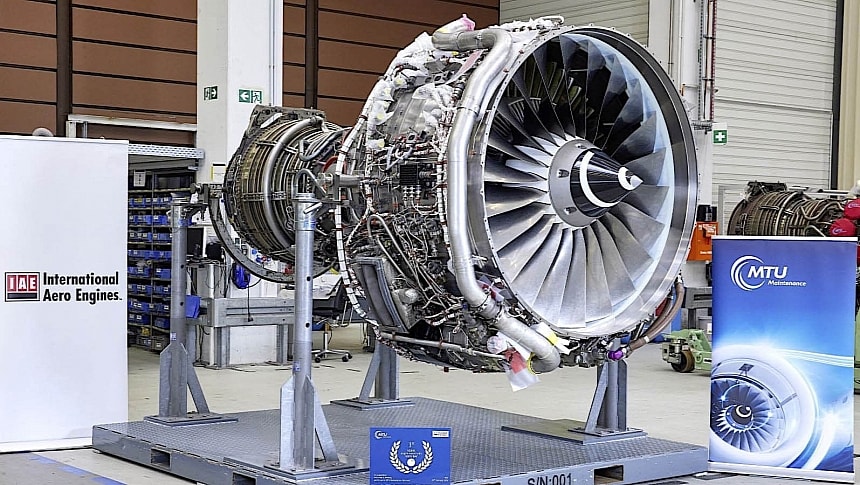The Airbus A320 family is one of the oldest and most reliable in the aviation industry. Born in Europe back in 1987 (that's almost 40 years ago), the range is also one of the most widespread, with over 11,000 of them made.
During such a long life, the A320 saw several incarnations and upgrades, with the one currently being produced called the A320neo. The older ones that are still in operation have been designated A320ceo, where "ceo," naturally, doesn't stand for chief executive officer, but "current engine option."
It is this type of aircraft that's of interest to us today because of a successful test performed on the engines that power it.
The A320ceo is a single-aisle aircraft equipped with two engines from a family called V2500. They are made by International Aero Engines (IAE), a conglomerate comprising Pratt & Whitney, Japanese Aero Engines Corporation and MTU Aero Engines, and are also deployed on the Embraer C-390 Millennium.
When using conventional fuel the V2500s allow the Airbus aircraft to travel for distances of up to 6,200 km (3,852 miles) while carrying up to 180 people and weighing as much as 78 tons.
Even on aviation fuel the V2500 engine is according to its maker "the most fuel-efficient propulsion system in its class," providing a three percent reduction in fuel consumption and emissions compared to what came before it.
As the aviation industry is moving toward the magical sustainable aviation fuel (SAF) and the reduction in CO2 emissions it promises, the people behind the engines are trying to see if this widespread powerplant family can run on the stuff. And guess what? It can.
As per an announcement made last week by the IAE, a test conducted over in Hannover, Germany, showed that the V2500 can burn SAF. Normally, this powerplant is certified to run on a mixture of Jet A and A-1 fuel with up to 50 percent SAF, but this time it burned solely the new fuel.
The exact substance used was 100 percent hydroprocessed esters and fatty acids, as well as synthetic paraffinic kerosine (HEFA-SPK), which was supplied by a specialized company, Neste.
HEFA-SPK is essentially a mixture of hydrotreated waste oils or fats. It is widely used in the industry, and a few months ago it was even used to power the world's largest airliner, the Airbus A380, during a test conducted by Emirates.
The fact that it's now a proven the engine can run solely on SAF is a huge deal. No less than 3,000 aircraft now operating in the skies of the world are powered by V2500s, and slowly making the switch for all of them could have a great impact on our world. And it will definitely have such an impact on the aviation industry's goal of being net zero by the middle of the century.
It is this type of aircraft that's of interest to us today because of a successful test performed on the engines that power it.
The A320ceo is a single-aisle aircraft equipped with two engines from a family called V2500. They are made by International Aero Engines (IAE), a conglomerate comprising Pratt & Whitney, Japanese Aero Engines Corporation and MTU Aero Engines, and are also deployed on the Embraer C-390 Millennium.
When using conventional fuel the V2500s allow the Airbus aircraft to travel for distances of up to 6,200 km (3,852 miles) while carrying up to 180 people and weighing as much as 78 tons.
Even on aviation fuel the V2500 engine is according to its maker "the most fuel-efficient propulsion system in its class," providing a three percent reduction in fuel consumption and emissions compared to what came before it.
As the aviation industry is moving toward the magical sustainable aviation fuel (SAF) and the reduction in CO2 emissions it promises, the people behind the engines are trying to see if this widespread powerplant family can run on the stuff. And guess what? It can.
As per an announcement made last week by the IAE, a test conducted over in Hannover, Germany, showed that the V2500 can burn SAF. Normally, this powerplant is certified to run on a mixture of Jet A and A-1 fuel with up to 50 percent SAF, but this time it burned solely the new fuel.
The exact substance used was 100 percent hydroprocessed esters and fatty acids, as well as synthetic paraffinic kerosine (HEFA-SPK), which was supplied by a specialized company, Neste.
HEFA-SPK is essentially a mixture of hydrotreated waste oils or fats. It is widely used in the industry, and a few months ago it was even used to power the world's largest airliner, the Airbus A380, during a test conducted by Emirates.
The fact that it's now a proven the engine can run solely on SAF is a huge deal. No less than 3,000 aircraft now operating in the skies of the world are powered by V2500s, and slowly making the switch for all of them could have a great impact on our world. And it will definitely have such an impact on the aviation industry's goal of being net zero by the middle of the century.






